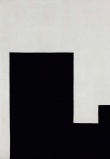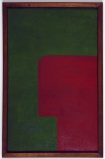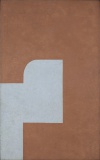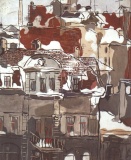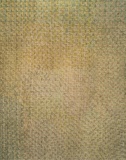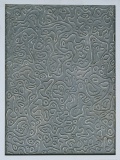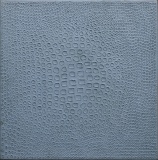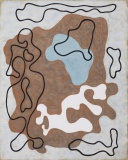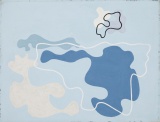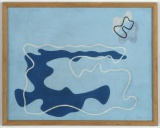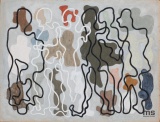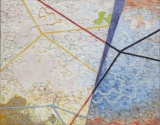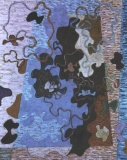Władysław Strzemiński
 Julian Przyboś, Władysław Strzemiński, Katarzyna Kobro, c1930. | |
| Born |
November 21, 1893 Minsk |
|---|---|
| Died |
December 28, 1952 (aged 59) Łódź, Poland |
| Web | Culture.pl, Artyzm, Wikipedia |
| Collections | MS Łódź 181, MoMA 6, Zachęta 2, KM Bochum 2, Pompidou 1 |
Władysław Strzemiński (1893-1952) was a Polish art theoretician and avant-garde painter and designer. He developed the theory of Unism.
Contents
Life and work[edit]
Born 1893 in Minsk into a family of Polish gentry, his father is a Lieutenant-Colonel officer of the Tsarist Army. Parents imagine him a military career, 1904-11 studies at the Tsar Alexandre II Cadet School in Moscow. 1911-14 studies at The Tsar Nicholaus Military School of Engineering (Voyennoe Inzhyneryinoe Uchylishche) in Petersburg, gains wide knowledge in the history of architecture and military construction. July 1914, shortly afler graduating, delegated as an officer of sappers to the Osowiec fortress in the Bialystok District; during WWI takes part in military operations on the Eastern Front, in command of a sappers' unit. May 1916 seriously injured by the explosion of a grenade in trenches, his eyeball injured, and right thigh and left forearm amputated in Prochorov Hospital in Moscow, what ruins his hopes for a military career, he is to use crutches till the end of his life. Meets his future wife Katarzyna Kobro who is a sister of mercy in the hospital and intends to study sculpture.
1917 fascinated by the private art collection of the factory owner Shchukin in Moscow, which includes a wide variety of French paintings from Impressionism to Cubism. Probably starts to study history and theory of art, also inspired by the artistic events in the wake of the October Revolution. May-November 1918 takes part in the meetings of the Subsection of Art and Artistic Industry, headed by Tatlin, within the framework of IZO Narkompros; the group includes Malevich and Pevsner. Autumn 1918 starts studying in the First Free Artistic Studios (SVOMAS, Svobodniye Masterskiye), opened in September in the old Strogonov School in Moscow; meets Kobro there again; later in 1919 leaves the school without graduation. December 1918 his paintings are among the ones purchased by IZO Narkompros for the prospective Museum of Artistic Culture in Petersburg. 1919 takes part in agitprop activities; February 1919 with Ciechanowski and the local IZO director Vsevolod Dmitrev designed the decoration of the Minsk city to celebrate the first anniversary of The Red Army. February 1919 nominated (together with Rodchenko) to the Moscow Committee of Art and Artistic Industry, which must have been an equivalent of the IZO Narkompros Subsection, in which he worked in the previous year. Together with Pevsner he directs The All-Russian Central Office of Exhibitions [Vsserossyiskoye Tsentralnoye Vystavochnoe Byuro], the institution founded within the IZO framework to organize exhibitions all over the country. Shows his paintings at the VIII exhibition in Moscow.
Autumn 1919 moves to Smolensk. Works as an instructor of the Subsection of Art in the Smolensk District Department of People's Education (GubONO, Gubernskiy Otdel Narodnogo Obrazovanya). December 1919 participates in an exhibition of local and Moscow-based artists, organized by Malevich. Takes part in the Manovich's circle which later forms the UNOVIS group. First half 1920 he is the director of the Section of Art of the Joint Departments of Museums and Fine Arts (Podotdel muzeyev y izobrazitelnykh iskustv) affiliated with GubONO; as a representative of the section he is made the secretary of the Arts Council, whose first meeting takes place in April 1920, where he presents the far left-wing views. March 1920 shows ten works at an exhibition in Smolensk, including sketches for the scenery of Mayakovsky's Buffo Mystery Play; works are later selected for the presentation in the Museums of Artistic Culture (MCHK, Muzeya Khudozhestvennoy Kultury). Summer 1920 Kobro comes to Smolensk; together they supervise the IZO Studio GubONO, affiliated with UNOVIS; and share studio on the main street of Smolensk (Bolshaya Sovetskaya). Malevich living in nearby Vitebsk often visits Smolensk; together they teach the principles of Cubism and Suprematism. 1920 exhibits with the UNOVIS group in Moscow. 1921 designs political posters with Kobro for the Russian Telegraphic Agency (ROSTA) which is affiliated to the same art section in Narkompros as the IZO. March 1921 takes part in a one-day show of UNOVIS in Vitebsk. Late 1921 or early 1922 marries Kobro before the registrar, and they "smuggle themselves" into Poland, after IZO Narkompros is restructured in October 1921 giving up its control to central political institutions pursuing the Bolshevik propaganda.
1922 the Strzemińskis spend a few weeks in the police station after illegal crossing of the state border. They first settle in Vilnius where Strzemiński's family had been living after his father's death. He teaches and lectures at Major Lukasinski Military Courses. October 1922 one of his paintings is shown at First Russian Art Exhibition in Berlin. His critical review of the development of Soviet art, "O sztuce rosyjskiej - notatki" [On Russian Art - Notes], gets published in two parts by Zwrotnica (November issue, and issue 4), a magazine edited by Peiper, his future long-time friend. Kobro leaves Vilnius, since she doesn't speak Polish, suffered from long periods of forced inactivity, and had to cope with her husband's family who were unfavorable towards her; moves to her relatives in Riga.
1923 he moves to Wilejka Powiatowa in search of a permanent job after the closure of the Major Lukasiewicz Courses. Till about mid-1924 he teaches drawing at the Henryk Sienkiewicz State High School drawing. Paints the synthetic, post-suprematist and post-cubist compositions, early realizations of the nascent theory of Unism. Starts to collaborate with Kairiūkštis, whom he probably met in Moscow; May 1923 in Vilnius they organise the first Polish exhibition of Constructivist art, The New Art Exhibition; Henryk Stażewski, Mieczysław Szczuka, and Teresa Żarnowerówna participate among others; Strzemiński writes an exhibition review for Zwrotnica. March 1924 co-founds the Constructivist Blok group, marked by the publication of the first issue of the Blok magazine edited by Szczuka, and by the group exhibition in a Warsaw automobile showroom Laurin-Clement. Before the opening, Kobro probably comes from Riga for a short time; then in July Strzemiński visits her in Riga to have a church wedding, which grants her a Polish citizenship.
Late summer 1924 they move to Szczekociny; he teaches drawing at the Co-educational High School of the District Department of the Wloszczowski Regional Council, possibly at the suggestion of the headmaster of the school, Adam Nowinski, a devotee of the new art. Visits Warsaw many times, taking part in meetings and discussions of the Blok group, held usually in Szczuka's flat or in the offices of the Polish Art Club in the Polonia Hotel. Remembering Moscow collections of modern art and their role in the artistic education of the people, Strzemiński makes the first, yet unsuccessful, attempt to organize a similar collection in Poland; in February 1931 letter to Julian Przyboś he writes that he "suggested to the members of the Blok that such a museum should be organized, but to no avail, because Szczuka was afraid of the technical and the painterly matters, of the painterly culture". In November-December 1924 issue of Blok he publishes an article "B=2", which is considered to be the first formulation of the theory of Unism; there he specifies what makes his views different from Szczuka's utilitarian theory. Exhibits with Blok group in Riga, maybe also in Brussels and Tallin. Opposing Malevich's Suprematism both in theory and practice, he produces monochromatic paintings, based on the principles of his own system, as Unistic (flat) Compositions. His name appears for the first time among the names of Polish Futurists in the magazine Rivista d'arte futurista published in the West. 1925 Blok disintegrates: Strzemiński doesn't take part in subsequent exhibitions and publications of the group. He is more attracted to the artists around the Krakow-based Zwrotnica, designs covers for its publications, including poetry books by Przyboś, whom he met earlier in the editorial office of the magazine, and becomes long-lasting collaborator and friend. Meets Szymon Syrkus and Bohdan Lachert, young architects from Warsaw. 1925 his painting is exhibited in MCHK (The Tretyakov Gallery) in Moscow together with the works by Sterenberg, Larionov, Drevin, Rozanova, and Altman. January-February 1926 presents his works at the International Theatre Exhibition in New York. Probably designs the whole art work for the sixth issue of Zwrotnica; in the following issues publishes reviews and polemical notes on modern art. Exhibits twice with the Artists' Guild Jednorog (Unicorn), a group of graduates of Krakow Academy, showing a series of Still Lifes and Landscapes paintings which stem from his structural analyses of Cubist paintings.
Summer 1926 the Strzemińskis move to Brzeziny near Łódź, and renew their contacts with Warsaw artists. He teaches drawing at the Stryjkowski High School of Humanities. October 1926 joins Praesens, the group of architects and painters founded by Syrkus earlier that year and including the former Blok members Stażewski and Kobro; participates at their exhibition in the Warsaw's Zacheta Gallery with a number of works: interior of the Sculptor's House designed with Epstein, a colour-design for Syrkus' 'Fur Shop' and for a church by Syrkus and Oderfeld, collaboration on the interior design of the Perskie Oko Theatre, and individual works: paintings on glass, book covers and illustrations; and contributes the catalogue text on functional painting and architecture. Returns to the idea of organizing a collection of modern art in Warsaw, drafts the statute (validated in September) of the Association of the Gallery of Modern Art, which functions for a short time, and only nominally, in the following year. Often visits Warsaw, staying usually at Lachert's. 1926 his first Architectural Compositions painted on canvas. January 1927 in a letter to Kairiūkštis he is critical about some of the painters from the Praesens group who supposedly wanted to "smuggle regard for modern art" by means of a compromise and a "kind of a contraband", "but actually the results will be the same as in Russia - temporary recognition and total neglect, because New Art should appear openly, with its face uncovered, it should stand unmasked and demand recognition not for its usefulness, but for its superiority". March 1927 Malevich visits Warsaw on his invitation, to show a selection of his works and lecture on new trends in art. April 1927 his first one-man exhibition is organized in the Polish Art Club; he lectures there about his artistic programme "Unizm i dualizm w sztuce" [Unism and Dualism in Art]; later published in the Summer issue of Droga magazine, and 1928 appears as a book entitled Unizm w malarstwie [Unism in Painting] in The Praesens Library series with the cover design by Stażewski. May 1927 shows two works at the Machine Age Exposition in New York: the lost Cafe and (together with Syrkus) the project for the Fur Shop, possibly the one presented earlier at an exhibition of the Praesens group.
Mid-1927 offered an attractive job in Koluszki where he has been teaching, and in order to avoid strenuous commuting, he moves with his wife to Zakowice. August/September he settles in Koluszki. Teaches drawing in two schools, the Co-educational High School on A. Mickiewicz Street, and the Girls' High School of Industry and Commerce. Soon he formulates and introduces his own educational programme for designers. November 1927 his painting from the MCHK collection Tools and Products of Industry is shown at the 'Novyje tecenija v isskustve' [New Tendencies in Art] exhibition in Leningrad. December 1927 exhibits in the City Art Gallery in Łódź with a group of local painters. Early 1928 correspondence with van Doesburg whose text along with articles by Strzemiński and others, is printed in the catalogue of the Modernists' Salon, opened in Warsaw in March, where Strzemiński exhibited several of his paintings from a series of studies on Cubism, five abstract compositions, a chair and a few drawings. 1928 publishes three articles on contemporary architecture in the Warsaw biweekly 'XX Century' edited by Stanislaw Baczynski; in "Przedmiot iprzestrzeri" [Object and Space] he introduces the notion of "the calculatory rhythm of a spatial phenomenon", a system different from the "system of contrasts", and which leads to the unity of object and space. 1928 receives the 2nd prize from the Polish Architect's Association for the design of a tobacco kiosk made with Kobro. November 1928 takes part in the 1st Exhibition of the Polish Artists' Union (ZZPAP) in Warsaw, repeated in January in Krakow (there with 29 works including still-lifes, landscapes, abstract paintings and drawings). Exhibits three paintings, among them Architectural Composition 2a and 4a, with the Praesens group at the Autumn Salon in Paris. December 1928 participates in an international show in Brussels, The Hague, and Amsterdam, organized by the Society for the Promotion of Polish Art Abroad (TOSSPO); exhibits again one of his paintings on glass and Still Life. 1929 the joint Praesens project of the interior design for the pavillions and exhibitions halls at the National Exhibition (PWK) in Poznan is his last attempt to come in terms with the group since by now it is dominated by Functionalists. June 1929 exhibits in Łódź with the Start group. 1929 designs graphic arrangements for Przyboś' poems. 1929 works on the programme of the new magazine Europa, edited by Stanislaw Baczynski, devoted to social and political matters, and which he wants to be the platform of the avant-garde; the first issue appears in two editions: in May and in September; he views the latter as a total disgrace, however keeps using the magazine as a means of popularizing the theory and the art of the avant-garde. June 1929 writes Przyboś about his plans to leave the Praesens group and prospects of organizing a new group "based on the broader principle of uniting all modernity - poetry, art, architecture". Autumn 1929 his and Kobro's book Kompozycja przestrzeni, obliczenia rytmu czasoprzestrzennego [Space Composition. Time-Space Rhythm and its Calculations] goes to print; corresponds with Georges Vantongerloo in connection with the book, only to be published 1932.
Late autumn 1929 forms a new group, a.r. (real avant-garde) with Kobro and Stażewski; Przyboś joins in December, and Jan Brzekowski next year. Writes "Bilans Modernizmu" [The Summing-up of Modernism], a brief recapitulation of his artistic career and the work of the Praesens group, and "Snobizm a Modernizm" [Snobism and Modernism] article on Szczuka's photo-montages for Europa. In the neighbouring Łódź he finds favourable conditions for locating the collection of modern art and starts to put it into life, managing to find support in the group and in Przedaw Smolik, the chairman of the Department of Education and Culture of the Municipal Council. 1929 paints more Architectural Compositions, and ultimately rejects the problem of "architectonics in painting" and "its dramatic character resulting from the contrast of forms", in favour of further search for the "organic unity" of the painting as a flat quadrangle. December 1929 physical exhaustion. January and February 1930 exhibits again with the Start group. April 1930 Przyboś' poems Z ponad [From Above] with Strzemiński's design are published as the first volume of the new publishing initiative a.r. Biblioteka [a.r. Library], meant as an opposition to Praesens. April 1930 first issue of Bulletin of the "a.r." group gets published. 1930 corresponds with Jan Tschichold from Munich and Herwarth Walden from Berlin and Bauhaus about setting up the avant-garde publications distribution in Poland and Europe. Making use of Stażewski's visit to Paris and Brzekowski's interest in the activities of the group, Strzemiński strives to gain gifts for the International Collection of Modern Art, by instructing the two artists what to look for; endless negotiations with the Municipal Council of Łódź about a place for the collection seems to be coming to a close; he himself asks for works of art from the representatives of European and Polish avant-garde, with whom he co-operated in various publications and other enterprises, and corresponds with Piet Mondrian, van Doesburg, Vantongerloo, Malevich, Marinetti, Żarnowerówna, Peiper, Wanda Chodasiewicz-Grabowska and others; first paintings for the collection are brought from Paris by Stażewski in mid-February, others follow in summer; in March he tries to establish a contact with Czech Modernists, yet to no avail. April 1930 the J.and K. Bartoszewicz Museum of History and Art in Łódź opens, although the collection of modern art is not yet available to the public for reasons beyond control; the catalogue of the first section of art prepared for this occasion includes Strzemiński's Kompozycje i studia fakturowe [Compositions and factural studies], exhibited in Room VI among works by Łódź artists. Summer 1930 suffers from heat stroke due to unusually high temperatures. In the third and the last issue of L'Art Contemporain - Sztuka Wspolczesna he publishes a text "Dramatyzm i architektonizm" [Dramatic Quality and Architectonics] summarizing his artistic career leading from the Unistic "flat" paintings through architectonic compositions towards the next stage, which was realized in "factural" Unistic paintings. September 1930 Malevich asks the group to organize his second exhibition in Poland, however the political situation in the Soviet Union and finally his premature death makes the project impossible. February 1931 his and Kobro's book Kompozycja przestrzeni [Space Composition] is finally published as the second volume in the "a.r." Library.
September 1931 the Strzemińskis move to Łódź; for a short time live in Piramowicza Street, in a one-room, primitive apartment; later in 56, Lipowa Street, fl. 10, equally small and uncomfortable; after a few weeks they move again to a much more comfortable flat in 22, 6 Sierpnia Street, flat 10. First works, of small formats, painted in distemper on cardboard are produced, belonging to the series City-scape of Łódź, which he is to continue painting in the following years. September 1931 starts working in the girls' State School of Industry and Commerce; soon becomes headmaster of the Public School of Technical Training no. 10, where he teaches typography and the principles of functional printing; among the graduates are his later friends and collaborators: Wladyslaw Gorski, Janusz Tusinski, Boleslaw Utkin. Late 1931 meets Stanislaw Ignacy Witkiewicz in Zakopane. November 1931 writes to Przyboś about the influence of Communism on modern art: "Communism [..] makes art sterile, it is hostile not only to the new forms of art, but also to any art in general [..] Until we do not trace all the social and ideological consequences of modern art - the logic of form - it will hang in the void and will not find any social extension." 1931 Kairiūkštis delivers a lecture in Vilnius about Strzemiński's Unism. February 1932 he is delegated by the General Assembly of the Polish Artists' Association (ZAP) in Łódź to take part in the editorial board of Glos Plastykow, an illustrated magazine on visual arts, published in Krakow, from mid-1933 the official organ and the national platform of the Polish Artists' Union ZZPAP; works there until 1938. March 1932 the illustrated catalogue of the International Collection of Modern Art is published; introduction by Przedaw Smolik; among 75 works three by Strzemiński; widely distributed, 50 copies sold in Paris by Brzekowski. May 1932 awarded the City of Łódź Award for Visual Arts, causing violent protests in the conservative circles led by the traditionalist painter Wadaw Dobrowolski which continue also the following year; he finds support in official and public pronouncements made by Przedaw Smolik, Leon Chwistek, the Lvov group Artes and others, Przyboś surprisingly remains silent. July 1932 takes part in the Organizational Committee of the 'New Generation' exhibition in Lvov. November 1932 Bulletin of the "a.r." group no. 2 is issued as a four-page, condensed leaflet. Late 1932 lectures at the Krakow Arts Academy, well attended by its students. 1932 joins the international group Abstraction-Création, together with Kobro and Stażewski; publishes two texts in their magazine. 1933 the Strzemińskis move to a modern three-room flat in 75, Srebrzynska Street nr 45, in the newly built Montwill Mirecki Housing Estate. Early 1933 the a.r. group establishes closer contacts with the Krakow Group [Grupa Krakowska] and the Paris artists from L'art Contemporain hoping to activate the weakening avant-garde movement; organize a one-time exhibition together as the Group of Modern Visual Artists [Grupa Plastykow Nowoczesnych], opened in March in Instytut Propagandy Sztuki [Institute for the Propaganda of Art] Warsaw and in autumn in Łódź; becoming the most important presentation of Strzemiński's works: showing 11 'Architectural Compositions', and nine 'Unistic Compositions' from the early and mature periods. Brzekowski's poems 'W drugiej osobie' with drawings by Hans Arp and Strzemiński's design is published as volume 4 of the "a.r." Library. May 1933 the first issue of the Forma quarterly appears, published irregularly until 1939; officially the organ of the Lodz section of the Polish Artists' Association (ZAP), and later the Polish Artists' Union (ZZPAP), in practice the platform for the a.r. group; edited by Karol Hiller, the board includes Strzemiński, Aniela Menkesowa, Stefan Wegner, Jerzy Krause, and in 1936 Kobro; he obtains the articles by Mondrian, Malevich, and others. 1933 develops the previously outlined theoretical foundations of the new art of printing in the text Druk funkcjonalny [Functional Print] published in Grafika magazine, and 1935 as volume 6 of the a.r. Library. 1933 his article "Sztuka miast i maszyn" [The Art of Cities and Machines] exploring the relations between art and post-industrial society, is published in one of the October issues of 'Glos Poranny'. 1934 analyzes Polish contemporary art from the Constructivist view in the article for 'Sztuka Nowoczesna w Polsce' [Modern Art in Poland] published by The Bibliophile Association. Spring 1935 due to financial difficulties, the Strzemińskis move to a new two-room flat in 75, Srebrzynska Street, ft 44, until the beginning of the war. May 1935 issue of Forma publishes a discussion in a series of letters begun in December of the previous year with Chwistek, a dispute between the representative of Unism and the founder of Strefism (the Theory of Zones); Chwistek's suggestion that the idea "anti-unism" might become the common platform for the two theories, is not accepted and the controversy remains unsolved. 1936 the a.r. group publishes Brzekowski's brochure Hans Arp written in French; intended as the first book in a series of similar publications, but these plans collapse because of the breaking up of the group and the disintegration of the whole Polish avant-garde movement. 1936 Strzemiński edits an album dedicated to Malevich, includes his own Suprematist lithography as an hommage to the artist. 1938 edits the Polish version of Jan Tschichold's book Typographische Gestaltung (Basel 1935) under the title 'Druknowoczesny' [Modern Typography]. 1939 the last 7th volume in the a.r. Library is published, his work Zasady kompozycji reklamowej [The Principles of Composition in Advertising]; the whole edition of which is destroyed shortly after the war outbreaks.
1945 becomes a lecturer at the State Higher School of the Visual Arts (SHSVA) in Łódź, which he also co-founded. Continues to pour his energies into the institution and one of his achievements is foundation of the Department of Spatial Visual Arts. That same year he donates much of his output to the Museum of Art in Łódź. 1948 he designs the Neo-Visual Room, which is today an integral part of the museum's permanent exhibition. 1950 he is stripped of his position at the SHSVA by decision of the Ministry of Culture and Art for failing to respect Socialist Realist doctrine. Dies 1952 in Łódź.
1956/57 Łódź and Warsaw host posthumous exhibitions of the work of Strzemiński and Kobro. His book Teoria widzenia [A Theory of Vision], written c1948-49, is published in 1958. A collected volume titled 'Władyslaw Strzemiński. In Memoriam' (Łódź, 1988) and Materials from a session organized in 1993 by the Museum of Art in Lodz on the 100th anniversary of the artist's birth (Łódź, 1994) are devoted to his lifetime achievements as an artist. 1993 the Museum of Art in Łódź organizes a major retrospective. In addition, Strzemiński's works are shown at numerous international exhibitions of avant-garde art.
Works[edit]
Green-Red-Architecture, 1928. Oil on cardboard. 47,5 x 30 cm. KM Bochum.
Kompozycja architektoniczna 10c [Architectonic Composition 10c], 1929. Oil on canvas. MS Łódź.
Pejzaż łódzki [Łódź Landscape], 1931. Tempera on cardboard. MS Łódź.
Kompozycja unistyczna [Unist Composition], 1932. Oil on gypsum. 40.6 x 30.4 cm. MoMA.
Kompozycja unistyczna 14 [Unist Composition 14], 1934. Oil on canvas. 50 x 50 cm. MS Łódź.
Kompozycja morska. Wenus, 1933. Tempera on cardboard. 25 x 20 cm. MS Łódź.
Pejzaż morski [Sea Lanscape], 1934. Tempera on cardboard. 21 x 27 cm. MS Łódź.
Pejzaż morski [Sea Lanscape], 1934. Gouache. 21 x 27 cm. KM Bochum.
Bezrobotni [Unemployed], 1934. Tempera on cardboard. MS Łódź.
Publications[edit]
- Unizm w malarstwie, 1928. (Polish)
- Kompozycja przestrzeni. Obliczenia rytmu czasoprzestrzennego [Spatial Composition: Calculating the Spacetime Rhythm] (with Katarzyna Kobro), Łódź: a.r. (Biblioteka a.r., 2), 1931, 79+[32] pp; repr., intro. Janusz Zagrodzki, Łódź: Łódzkie Towarzystwo Przyjaciół Książki, 1974; facsimile repr., Łódź: Muzeum Sztuki, 1993; fragments repr., ed. Nika Strzemińska, Sztuka i Filozofia 13, 1997, 88-99. (Polish)
- Druk funkcjonalny, Łódź: a.r., 1935. [2] (Polish)
- Druk nowoczesny, 1938. [3]. (Polish)
- Kazimierz Malewicz 1876-1935, Łódź: self-published, 1936. Album containing twenty-six lithographs and eleven gelatin silver prints.
- Teoria widzenia, intro. Julian Przyboś, Kraków: Wydawnictwo Literackie, 1958; new ed., ed. & intro. Iwona Luba, Łódź: Muzeum Sztuki in Łódź, 2016, 342 pp. Excerpt. A treatise of visual consciousness as a foundation for progressive art, emphasizing art’s autonomy. Applies Marxist aesthetics to the physiology of seeing. Published posthumously by Strzemiński's students from notes collected from his lectures. [4] (Polish)
- Theory of Seeing, forew. Daniel Muzyczuk, trans. Klara Kemp-Welch and Wanda Kemp-Welch, University of Minnesota Press (e-flux Classics), 2025, 312 pp. Publisher. (English)
- Wybór pism estetycznych, ed. Grzegorz Sztabiński, Kraków: Universitas, 2006, 208 pp. TOC. (Polish)
Correspondence[edit]
- "Listy Władysława Strzemińskiego do Juliana Przybosia z lat 1929-1933", ed. Andrzej Turowski, Rocznik Historii Sztuki 9, Wroclaw, 1973. (Polish)
Catalogues[edit]
- Katja Strunz Zeittraum #9 für Wladyslaw Strzeminski (Afterimages of Life), ed. Jarosław Lubiak, Cologne: Walther Koenig, and Łódź: Muzeum Sztuki in Łódź, 2011, 84 pp. [5] [6] (German)/(Polish)/(English)
- Powidoki życia. Władysław Strzemiński i prawa dla sztuki / Afterimages of Life: Wladyslaw Strzeminski and Rights for Art, ed. Jarosław Lubiak, Łódź: Muzeum Sztuki in Łódź, 2012, 773 pp. [7] [8] [9] (Polish)/(English)
- Kobro and Strzemiński: Avant-Garde Prototypes, Madrid: Museo Nacional Centro de Arte Reina Sofía, and Łódź: Muzeum Sztuki in Łódź, 2017, 192 pp. Contributions by Jarosław Suchan, Christina Lodder, Gladys C. Fabre, Juan Manuel Bonet; and texts by Kobro and Strzemiński. (English)
- Kobro y Strzemiński. Prototipos vanguardistas, Madrid: Museo Nacional Centro de Arte Reina Sofía, and Łódź: Muzeum Sztuki in Łódź, 2017, 264 pp. (Spanish)
- Une avant-garde polonaise: Katarzyna Kobro et Władysław Strzemiński / A Polish Avant-Garde, eds. Jarosław Suchan, et al., Skira, Paris: Centre Pompidou, and Łódź: Muzeum Sztuki in Łódź, 2018, 200 pp. [10] (French)/(English)
- Kobro & Strzemiński. Ny konst i turbulenta tider / New Art in Turbulent Times, eds. Iris Müller-Westermann and Linnea Jahn, Malmö: Moderna Museet Malmö, and Łódź: Muzeum Sztuki w Łodzi, 2018, 176 pp. [11] (Swedish)/(English)
Literature[edit]
- Books
- Nika Strzemińska, Miłość, sztuka i nienawiść: o Katarzynie Kobro i Władysławie Strzemińskim [Love, Art and Hate], Warsaw: Res Publica, 1991, 118 pp; new ed., Warsaw: Scholar, 2001, 228 pp. (Polish)
- Paweł Polit, Jarosław Suchan (eds.), Władysław Strzemiński. Czytelność Obrazów, Łódź: Muzeum Sztuki w Łodzi, 2012, 221 pp. Conference proceedings. [12] (Polish)
- Władysław Strzemiński: Readability of Images, Łódź: Muzeum Sztuki in Łódź, 2012, 221 pp. [13] (English)
- Iwona Luba, Ewa Paulina Wawer, Władysław Strzemiński. Zawsze w awangardzie. Rekonstrukcja nieznanej biografii 1893-1917 [Władysław Strzemiński. Always Avant-Garde: Unknown Biography, a Reconstruction, 1893-1917], Łódź: Muzeum Sztuki w Łodzi, 2017, 277 pp. [14] (Polish)
- Luiza Nader, Afekt Strzemińskiego. „Teoria widzenia”, rysunki wojenne, Pamięci przyjaciół - Żydów, Instytut Badań Literackich PAN, Warsaw: Akademia Sztuk Pięknych w Warszawie, and Łódź: Muzeum Sztuki w Łodzi, 2018, 400 pp. [15] (Polish)
- Articles
- Irena Urbaniakowa, "Julian Przyboś i Władysław Strzemiński w grupie 'a.r.' w świetle postulatu korespondencji sztuk", Rocznik Towarzystwa Literackiego imienia Adama Mickiewicza 23 (1988), pp 67-74. (Polish)
- Yve-Alain Bois, "Strzemiński and Kobro: In Search of Motivation", in Bois, Painting as Model, MIT Press, 1990, pp 123-155, n296-302. (English)
- Esther Levinger, "Return to Figuration: Władisław Strzemiński and the Move from Idealism", Art History 24:1 (2001), pp 101-131. (English)
- Irena Kossowska, "Władysław Strzemiński", Culture.pl, 2001. (English)
- Remigiusz Grzela, "Katarzyna Kobro i Wladyslaw Strzeminski. Rozmowa z ich córką – Niką", 2005. (Polish)
- Tomasz Załuski, "Władysław Strzemiński po wojnie: modernizacja, marksizm, socrealizm", in Socrealizmy i modernizacje, eds. Aleksandra Sumorok and Tomasz Załuski, Łódź: Akademia Sztuk Pięknych im. Władysława Strzemińskiego w Łodzi, 2017, pp 229-268. (Polish)
- Tomasz Załuski, "Art as an Agent of Modernisation. Władysław Strzemiński’s Double Politics of Social Change, the Museum, and Artistic Culture", Widok 20, 2018. (English)
- Essays on Strzemiński at AMUR repository
- http://www.artrz.ru/1804786754.html
- Theses
- Barbara Iwona DeBoer, Four Arts Redefined. Władysław Strzemiński's Theory of Unism, University of Maryland, 2005. Master's thesis.
- Film
- Powidoki [Afterimage], dir. Andrzej Wajda, 2016, 102 min. Feature film on Strzemiński's last years. IMDB.
See also[edit]
Links[edit]
- Comprehensive resource on Strzemiński
- "Afterimages of life. Wladyslaw Strzeminski and rights for art", monographic exhibition in Muzeum Sztuki, Lodz, 2010-11. Video report.




